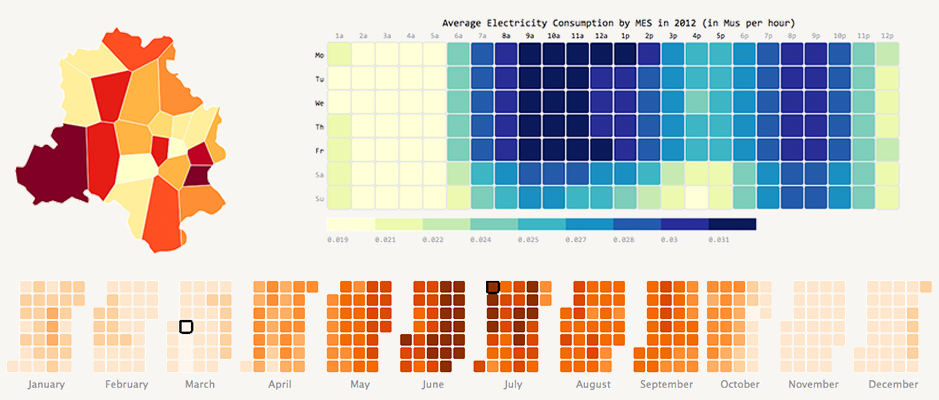Delhi Energy Project

In 2006, the United Nations Development Programme, the UN Millennium Project, and the World Bank issued a joint statement:
The world has an unprecedented opportunity to improve the lives of billions of people by meeting the Millennium Development Goals (MDGs), the international community’s time-bound and quantified targets for addressing extreme poverty in its many forms.
[…] A common finding of the ten Task Forces of the UN Millennium Project has been the urgent need to improve access to energy services as essential inputs for meeting each MDG. Without increased investment in the energy sector, the MDGs will not be achieved in the poorest countries
(Modi et al. 2006).
Project Type: Sustainable Energy
Location: Delhi, India
Links:
A Year in Review
Week by Week
Spatial Map
Menu:
Motivation
Case Study Selection
Local Context
Data
References
Related Blog Entries
Motivation
Today, significant progress has been made in improving energy access throughout the developing world. Yet disparities persist. One critical yet often under-appreciated area of disparity is in places with nominal access to modern energy services but high localized variability. This can be particularly acute in developing world mega-cities where the difference between rich and poor neighborhoods transcends income and includes access to basic infrastructure and city services (Sperling 2014). While the urban-rural divide in energy access is well known — with multiple studies citing that urban residents have, on average, higher per-capita energy use than their rural counterparts (Pachauri 2004, Pauchauri and Spreng 2004, Chavez et al. 2012) — averages do not tell the full story. Pachauri (2004) demonstrates within-group variation by computing quantiles of per capita energy requirements for urban and rural households using micro-survey data. Pachauri finds similar levels of total direct energy use for the bottom 40 percentile of urban and rural households based on household expenditures. However, similarities dissipate at higher expenditure levels, with the top 10 percentile of urban households consuming on average 38% more end-use energy than the top 10 percentile of rural households. Our study builds on Pachauri’s findings by drilling deeper for one city using high resolution observational data (as opposed to survey data). We expect to find much larger disparities between high-income and low-income (and especially informal) urban neighborhoods than previously documented in the literature.Case Study Selection
Intra-urban (e.g. within-city) disparities are known to be acute in developing-world mega-cities, which bear the weight of massive — and growing — populations. Public infrastructure and essential city services are often lacking to begin with, and are further overwhelmed by the influx of rural-to-urban migration. This study will investigate neighborhood-level disparities in energy access, reliability and consumption for Delhi, India. All three elements — access, reliability and consumption — are necessary for achieving the ten-year Millennium Development Goals (MDG), and the current Sustainable Development Goals (SDG) including the ambitious Sustainable Energy For All (SE4ALL) 2030 initiative. SE4ALL vows to:- Ensure universal access to modern energy services.
- Double the global rate of improvement in energy efficiency.
- Double the share of renewable energy in the global energy mix.
Local Context
Delhi is the world’s second largest city (UN 2009) with a population of 22 million and an observed growth rate of nearly 40% over the last decade (Delhi Statistical Handbook 2012). The megacity’s shear size and rapid growth are compounded by increasing per-capita demand for energy, water and materials (Delhi Statistical Handbook 2012); placing ever-increasing stress on finite local resources (Upadhyay 2011; Paliwal et al. 2006; CPCB 2006) and increasing the city’s reliance on trans-boundary resources and trans-boundary infrastructures (Cohen and Ramaswami 2014). Delhi, like developing cities the world over, is undergoing a dramatic transformation in the way it uses energy. In just two years from 2010-2012, peak energy demand in Delhi increased 15% (4677 MW to 5407 MW) and energy consumption increased an astounding 30% (20.35 TWh to 26.65 TWh). Follow the links below for interactive data visualizations that help explore the data.Data
The foundation of this study is a complete observational record of electricity demand and consumption data for the National Capital Territory of Delhi (NCT Delhi) from 2008-2013. The data has both high temporal resolution (15-minute) and high spatial resolution (11-kV feeder level, of which there are more than 150 across the city).Data was compiled from five electric utilities:
- BSES Rajdhani Power Ltd. (BRPL)
- BSES Yamuna Power Ltd. (BYPL)
- North Delhi Power Limited (NDPL)
- New Delhi Municipal Corporation (NDMC)
- Military Engineer Services (MES)
References
Modi, V., S. McDade, D. Lallement, and J. Saghir. 2006. Energy and the Millennium Development Goals. New York: Energy Sector Management Assistance Programme, United Nations Development Programme, UN Millennium Project, and World Bank.
Sperling, J. 2014. Exploring the Nexus of Infrastructures, Environment, and Health in Indian Cities: Integrating Multiple Infrastructures and Social Factors with Health Risks. Ph.D. Thesis: Univ. of Colorado.
Pachauri, S. & Spreng, D. (2004) Energy Use and Energy Access in Relation to Poverty. Economic and Political Weekly, Vol. 39, No. 3 (Jan. 17-23, 2004), pp. 271-278
Chavez, A., A. Ramaswami, N. Dwarakanath, R. Ranjan and E. Kumar. 2012. Implementing Trans-Boundary Infrastructure-Based Greenhouse Gas Accounting for Delhi, India. Journal of Industrial Ecology 16(6): 814-828.
United Nations, Department of Economic and Social Affairs, Population Division (2010). World Urbanization Prospects: The 2009 Revision. CD-ROM Edition – Data in digital form (POP/ DB/WUP/Rev.2009).
Upadhyay, R., Dasgupta, N., Hasan, A. & Upadhyay, S. K. Managing water quality of River Yamuna in NCR Delhi. Physics and Chemistry of the Earth, Parts A/B/C 36, (2011).
Paliwal, R., Sharma, P. & Kansal, A. Water quality modelling of the river Yamuna (India) using QUAL2E-UNCAS. Journal of environmental management 83, 131–44 (2007).
CPCB (Central Pollution Control Board), 2006–2007. Water Quality Status of Yamuna River, Assessment and Development of River Basin Series: ADSORBS/41/2006–2007. Published by Central Pollution Control Board (CPCB), Delhi, India.
Cohen, E. and A. Ramaswami. 2014. The Water Withdrawal Footprint of Energy Supply to Cities. Journal of Industrial Ecology, 18: 26–39. doi: 10.1111/jiec.12086


